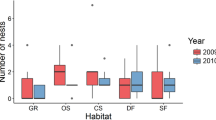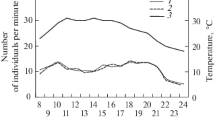Abstract
Camponotus sericeiventris is a polymorphic ant living in populous colonies at tropical forests and cerrado formation. This study provides a detailed account of the natural history and foraging biology of C. sericeiventris in cerrado at Ecological Station of Panga, Southeast of Brazil. The nest distribution according to vegetation physiognomies, activity rhythm, diet, and foraging patterns were described. Results showed that nests occur inside dead or live trunks, and also in branches of soft wood at cerradão and gallery forest physiognomies (approximately 1 nest/100m2), but not in the mesophytic forest. Ant activity is correlated with temperature and humidity. There is overlap in the foraging area among neighbor colonies (as far as 28 m) without evidence of agonistic interactions. Foragers leave the nest independently or in groups and frequently searched for food individually. Workers are generalistic feeders visiting flowers and extrafloral nectaries, attending Hemiptera (aphids and membracids) and Lepidoptera (Lycaenidae larvae), collecting seeds and fruits, and hunting for live preys as well as scavenging for dead animals. The great number of interactions with different plant and animals suggests that this species has an important participation in the interaction web in this environment.



Similar content being viewed by others
References
Altmann J (1974) Observational study of behavior: sampling methods. Behavior 49:227–267
Beattie AJ (1985) The Evolutionary Ecology of Ant-Plant Mutualism. Cambridge University Press, Cambridge
Bowser M (2002) http://www.uaf.edu/museum/ento/Insect_Omnibus/Camponotus/herculeanus.html Accessed in 10.10.2007
Busher CE, Calabi P, Traniello JFA (1985) Polymorphism and division of labor in the Neotropical ant Camponotus sericeiventris Guérin (Hymenoptera: Formicidae). Ann Entomol Soc Am 78:221–228
Cannon CA (1998) Nutritional Ecology of the Carpenter Ant Camponotus pennsylvanicus (De Geer): Macronutrient Preference and Particle Consumption. Doctor Thesis of Philosophy in Entomology. Virginia, USA
Carrol CR, Janzen DH (1973) Ecology and foraging by ants. Annu Rev Ecol Syst 4:231–257
Cogni R, Freitas AVL (2002) The ant assemblage visiting extrafloral nectaries of Hibiscus pernambucencis (Malvaceae) in a mangrove forest in Southeast Brazil (Hymenoptera: Formicidae). Sociobiology 40:373–383
Cogni R, Oliveira PS (2004) Patterns in foraging and nesting ecology in the neotropical ant, Gnamptogenys moelleri (Formicinae, Ponerinae). Insect Soc 51:123–130
Davidson DW, Brown JH, Inouye RS (1980) Competition and the structure of granivore communities. Bioscience 30:233–238
Davidson DW, Patrell-Kim LJ (1996) Tropical arboreal ants: why so abundant? In: Gibson A (ed) Neotropical Biodiversity and Conservation. UCLA Herbarium Publ, Los Angeles, pp 127–140
Davidson DW, Cook SC, Snelling RR, Chua TH (2003) Explaining the abundance of ants in lowland tropical rainforest canopies. Science 300:969–972
Davidson DW, Castro-Delgado SR, Arias JA, Mann J (2006) Unveiling a ghost of Amazonian rain forests: Camponotus mirabilis, engineer of Guadua bamboo. Biotropica 38:653–660
Del-Claro K, Oliveira PS (1999) Ant-homoptera interactions in a Neotropical savanna: the honeydew-producing treehopper, Guayaquila xiphias (Membracidae), and its associated ant fauna on Didymopanax vinosum (Araliaceae). Biotropica 31:135–144
Del-Claro K, Oliveira PS (2000) Conditional outcomes in a neotropical ant-homoptera mutualistic association. Oecologia 124:156–165
Del-Claro K (2004a) Multitrophic relationships, conditional mutualisms, and the study of interaction biodiversity in tropical savannas. Neotrop Entomol 33:665–672
Del-Claro K (2004b) Comportamento animal—uma introdução à ecologia comportamental. Livraria e editora Conceito, Jundiaí
Fittkau EJ, Klinger H (1973) On biomass and trophic structure of the central Amazonian rain forest ecosystem. Biotropica 5:2–14
Fourcassié V, Oliveira PS (2002) Foraging ecology of the giant Amazonian ant Dinoponera gigantea (Hymenoptera: Formicidae: Ponerinae): activity schedule, diet, and special foraging patterns. J Nat His 36:2211–2227
Gadau J, Brady SG, Ward PS (1999) Systematics, distribution, and ecology of an endemic California Camponotus quercicola (Hymenoptera: Formicidae). Ann Entomol Soc Am 92:514–522
Hölldolbler B, Wilson EO (1990) The ants. The Belknap Press of Harvard University Press, Cambridge
Kohl E, Hölldobler B, Bestmann HJ (2003) Trail pheromones and Dufour gland contents in three Camponotus species (C. castaneus, C. balzani, C. sericeiventris: Formicidae, Hymenoptera). Chemoecology 13:113–122
Longino JT (2002) http://www.evergreen.edu/ants. Accessed in November 2003
Lorenzi H (1998) Árvores Brasileiras—manual de identificação e cultivo de plantas arbóreas brasileiras do Brasil, vol 1/2. Editora Plantarum, Nova Odessa, São Paulo
Machado G, Freitas AVL (2001) Larval defence against ant predation in the butterfly Smyrna blomfildia. Ecol Entomol 26:436–439
Mody K, Linsenmair KE (2003) Finding its place in a competitive ant community: leaf fidelity of Camponotus sericeus. Insectes Soc 50:191–198
Myers N, Mittermeier RA, Mittermeier CG, Fonseca GAB, Kent J (2000) Biodiversity hotspots for conservation priorities. Nature 403:853–858
Oliveira Filho AT, Ratter JA (2002) Vegetation physiognomies and woody flora of the cerrado biome. In: Oliveira PS, Marquis RJ (eds) The cerrados of Brazil. Ecology and natural history of a Neotropical savanna. Columbia University Press, New York, pp 91–120
Oliveira PS, Brandão CRF (1991) The ant community associated with extrafloral nectaries in the Brazilian cerrados. In: Cutler DF, Huxley CR (eds) Ant–plant interactions. Oxford University Press, Oxford, pp 198–212
Oliveira PS, Del-Claro K (2005) Multitrophic interactions in a neotropical savanna Ant-hemipteran systems, associated insect herbivores, and a host plant. In: Burslem DFRP, Pinard MA, Hartley SE (eds) Biotic Interactions in the Tropics. Cambridge University Press, Cambridge
Oliveira PS, Marquis RJ (2002) The cerrados of Brazil – Ecology and natural history of neotropical savanna. Columbia University Press, New York
Oliveira PS, Da Silva AF, Martins AB (1987) Ant Foraging on Extrafloral Nectaries of Qualea grandiflora (Vochysiaceae) in Cerrado Vegetation—Ants as Potential Antiherbivore Agents. Oecologia 74:228–230
Oliveira PS, Rico-Gray V, Dias-Castelazo C, Castillo-Guevara C (1999) Interaction between ants, extrafloral nectaries, and insect herbivores in Neotropical coastal sand dunes: herbivore deterrence by visiting ants increases fruit set in Opuntia stricta (Cactaceae). Funct Ecol 13:623–631
Orr AG, Charles JK (1994) Foraging in the Giant Forest Ant, Camponotus gigas (Smith) (Hymenoptera, Formicidae)—Evidence for Temporal and Spatial Specialization in Foraging Activity. J Nat Hist 28:861–872
Pfeiffer M, Linsenmair KE (2000) Contributions to the life history of the Malaysian giant ant Camponotus gigas (Hymenoptera, Formicidae). Insectes Soc 47:123–132
Price PW, Diniz IR, Morais HC, Marques ESA (1995) The abundance of insect herbivore species in the tropics: high local richness of rare species. Biotropica 27:468–478
Ribas CR, Schoereder JH, Pic M, Soares SM (2003) Tree heterogeneity, resource availability, and larger scale process regulating arboreal ant species richness. Austral Ecol 28:305–314
Rico-Gray V (1993) Use of plant-derived food resources by ants in the dry tropical lowlands of Coastal Veracruz, México. Biotropica 25:301–315
Rico-Gray V, García-Franco JG, Palacios-Rios M, Díaz-Castelazo C, Parra-Tabla V, Navarro JA (1998) Geographical and seasonal variation in the richness of ant-plant interactions in Mexico. Biotropica 30:190–200
Rosa R, Lima SC, Assunção WL (1991) Abordagem preliminar das condições climáticas de Uberlândia (MG). Soc Nat 3:91–108
Santos JC (2002) Ecologia e comportamento de formigas tecelãs (Camponotus) do cerrado brasileiro. Dissertação de mestrado. Uberlândia, MG
Santos JC, Yamamoto M, Rodrigues F, Del-Claro K (2005) Behavioral repertory of the weaver ant Camponotus (Myrmobrachys) senex (Hymenoptera: Formicidae). Sociobiology 46:27–37
Schiavini I, Araújo GM (1989) Condições sobre a vegetação da Reserva Ecológica do Panga (Uberlândia). Soc Nat 1:61–66
Schilman PE, Roces F (2005) Energetics of locomotion and load carriage in the nectar feeding ant, Camponotus rufipes. Physiol Entomol 30:332–337
Silva RR, Brandão CRF, Silvestre R (2004) Similarity between Cerrado localities in Central and Southeastern Brazil base don the dry season bait visitors ant fauna. Stud Neotrop Fauna E 39:191–199
Soares SM, Schoereder JH (2001) An- nest distribution in a remnant of tropical rainforest in southeastern Brazil. Insectes Soc 48:280–286
Smythe N (1982) The seasonal abundance of night-flying insects in a neotropical Forest. In: Leigh Jr EG, Windsor DM (eds) The ecology of a tropical rain forest Smithsonian. Institution Press, Washington, D.C., pp 309–318
Traniello JFA (1989) Foraging strategies of ants. Ann Rev Entomol 34:191–210
Wheeler WM (1910) Ants: their structure, development and behavior. New York, Columbia University Press
Wheeler WM (1931) The ant Camponotus (Myrmepomis) sericeiventris and its mimic. Psyche 38:86–98
Wilson EO (1976) Which are the most prevalent ant genera? Studia Entomol 19:187–200
Wilson EO (1980) Castes and division of labor in leaf-cutter ants (Hymenoptera: Formicidae: Atta). Behav Ecol Sociob 7:143–156
Wilson EO (1987) Causes of ecological success: the case of the ants. J Anim Ecol 56:1–9
Acknowledgments
We thank Inara Leal, Jean Carlos Santos, and two anonymous referees for helpful suggestions on the manuscript. Financial support was provided to M.Y. by Capes and K.D.C. by the Brazilian Research Council (CNPq) and Fapemig. We confirm that our study comply with the current laws in Brazil, authorization number 12427-1 IBAMA.
Author information
Authors and Affiliations
Corresponding author
Additional information
Communicated by R.F. Oliveira
Rights and permissions
About this article
Cite this article
Yamamoto, M., Del-Claro, K. Natural history and foraging behavior of the carpenter ant Camponotus sericeiventris Guérin, 1838 (Formicinae, Campotonini) in the Brazilian tropical savanna. acta ethol 11, 55–65 (2008). https://doi.org/10.1007/s10211-008-0041-6
Received:
Revised:
Accepted:
Published:
Issue Date:
DOI: https://doi.org/10.1007/s10211-008-0041-6




